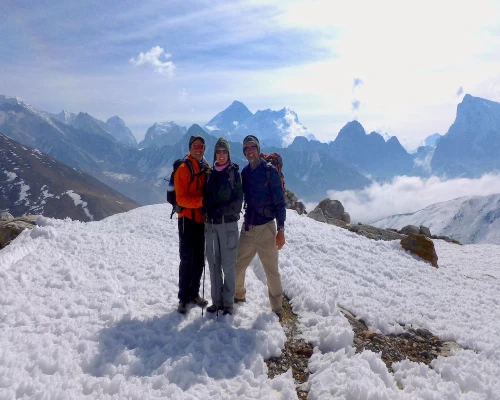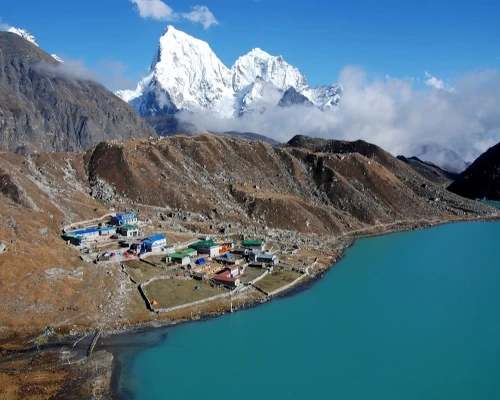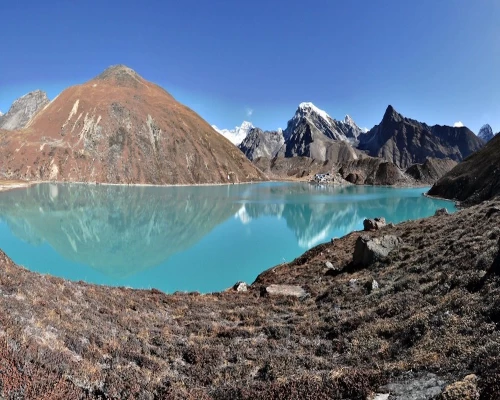Gokyo Valley Trek is a place that is unspeakable in words. Only some places on the Earth can come quite close to the magnificence of the valley because the valley displays breathtaking landscapes, pristine freshwater blue lakes, some of the world's tallest mountains, vast meadows, natural variety, cultural exhibits, and more. Thus, we are so exhilarated to invite you to do a superb trek in Gokyo Valley with the team of Mountain Rock Treks.
Undoubtedly, Gokyo Valley Trekking is one of the fantastic treks in Nepal.
The trek happens in the picturesque valley in the famous Everest Region, home to Mount Everest, Cho Oyo, Lhotse, and Makalu. The valley lying around 42km from Lukla, Gokyo Valley, is flooded and abundant in beauty.
As said earlier, the valley owns countless colors; that’s why it's a prime destination for trekking. Yet, the two best shades of exquisite Gokyo Valley Trekking are the Gokyo Lakes and Gokyo Ri.
First, Gokyo Lakes are six freshwater lakes in the valley at around 4,700m-5,000m. The trek runs through five of the pretty Gokyo Lakes lakes out of six. Those glittering lakes enclose mountains in the backdrop, making them even more heavenly.
Gokyo Ri(5,357m), another shade of Gokyo Valley, is a hilltop in the Khumbu Region above Gokyo Village. It is the highest point of Gokyo Valley Trekking. Various sky-towering mountains, the entire Gokyo Valley, Everest Region, glaciers, and Himalayan lakes are visible from its top.
Besides those two highlights, the hike through Gokyo Valley is full of multiple things, adventures, and experiences. The items can be numerous hanging bridges, iconic houses, inspiring lifestyles of locals, centuries-old gompas & monasteries, mani walls, rushing rivers, peaceful meadows, terrace fields, flora & fauna, and many more.
So this Gokyo Valley Trek, an exclusive trek, will take you to the Gokyo Lakes and the Gokyo Ri, along with many other scenic and worthwhile stops. Overall, you will have a fantastic travel experience. For that, you will require fourteen days. The trek lasts precisely 14 days, beginning and ending in Kathmandu.
The journey to Gokyo Valley starts with a flight to Lukla, the entrance to Khumbu Region. Then the walk continues through Phakding and Namche Bazaar, the popular stops of Everest Base Camp Trek. After Namche, the trail separates from Everest Base Camp Trek’s route when you take a road to Dole.
Resuming the trek, you will enter the Gokyo Valley to explore its sceneries. You will traverse the Gokyo Lakes, climb Gokyo Ri, and visit the villages of Gokyo Valley. It will be a time to enjoy and experience the Gokyo Valley.
Following the complete exploration of the valley, you will retrace to Lukla via Sherpa territories like Namche Bazar, Jorsale, and Phakding. And with a flight back to Kathmandu from Lukla, We will complete the trek within fourteen days.
Nonetheless, the trek is a little demanding. To enjoy the fruits of the tour, you will have to face several adversities. On average, you have to trek for 5-6 hours daily. The route will be steep, rough, and dramatic. High altitudes can be another problem. Likewise, the weather up in the region is chilly and testing. So these are the significant challenges of the trek.
You are pretty suitable for Gokyo Valley Trek if you take those challenges. You require an excellent physical endurance level, enough gear & clothing, and a little physical and mental training before the trek. If you are an experienced trekker, that would be a plus point. You can comfortably do the tour.
The best times to go to Gokyo Valley are Autumn and Spring, the two peak trekking seasons in Nepal. In those two seasons, the weather conditions in Nepal favor beautiful trekking experiences for visitors. Therefore, you shall have a remarkable trek under the attractive weather conditions in the valley.
If you ever feel like choosing this trek, we are always here to guide you across the valley. To reach us, we shall have a fabulous time in Gokyo Valley together.
Fact Behind Gokyo Lake
Gokyo Lakes are freshwater oligotrophic lakes in the Khumbu Region of Nepal. The lakes are one of the world’s highest freshwater lake systems. In total, there are six leading lakes in the Gokyo Lake System. Otherwise, the lake system, also a wetland area, has 19 lakes stretched over 485 acres at altitudes between 4,600m to 5,100m.
The excellent lake system resides in Khumjung VDC of Solukhumbu district in north-eastern Nepal. It is from the same region as the eight-thousanders like Mt Everest, Cho Oyu, Lhotse, and Makalu. And the valley that homes those lakes is known as Gokyo Valley.
Thomas Lake is the largest and deepest one of the six leading lakes. And Gokyo Cho or Dudh Pokhari, a lake by Gokyo Village, is the most popular of all the lakes. The other lakes are Gyazumpa Cho, Tanjung Cho and Ngojumba Cho. These lakes’ water sources are Ngozumpa Glacier- the longest glacier in the Himalayas, and various streams from the mountains. The region can be the best place for lake lovers to explore.
Moreover, Hindu and Buddhist pilgrims take these lakes as sacred ones. In August, thousands of people take holy baths in the lakes. According to the belief, the lakes are famous for connecting to Hindu deities such as Lord Shiva and Vishnu. So the place is religiously essential as well.
And Gokyo Valley receives numerous trekkers every year. The Gokyo Lakes have a significant role in attracting them. People across the globe visit the Gokyo Valley to explore these Gokyo Lakes. As it is in the same district as Everest Base Camp Trek, the crowded trail of Nepal, people choose to hike to these lakes for a peaceful trekking experience.
Fact about Gokyo Ri
Gokyo Ri(5,367m) is a mountain pass in Nepal's Gokyo Valley of the Everest Region. Located above the Gokyo Village and west of Ngozumpa Glacier, Gokyo Ri is one of the most famous mountain passes in the country.
The hilltop is best known for its striking mountain views of various mountains of the Mahalangur Range, a mountain range in the Himalayas. You can see peaks such as Cho Oyu, Lhotse, Makalu, Lhotse, Ama Dablam, and more. Moreover, the point is the highest point of Gokyo Valley Trekking. It is the major highlight of the treks that run through Gokyo Valley. While doing the Everest Three High Passes Trek, Gokyo Ri can be another popular trek in the region.
Gokyo Ri not only provides mountain views but other things too. You can investigate the whole Gokyo Valley and Khumbu Region from the top. In addition, the Gokyo Lakes, Gokyo Village, and Ngozumpa Glacier are equally rewarding. There is even a popular trek that goes by Gokyo Ri Trek. On this trek, the mountaintop is the ultimate point.
Some people believe that the view of Mt Everest from Gokyo Ri is better than that ofKala Patthar, the best viewpoint of Mt Everest. If so, Gokyo Ri is undoubtedly a special place to hike. You can reach the top by walking above Gokyo Village. The hike to Gokyo Ri from Gokyo Village takes only 4 hours. It involves a strenuous hike of several hours. But the view that you get from the top is worth it. You will remain awe-struck by the panorama.
If you are ever in Gokyo Valley, do not forget to hike up to Gokyo Ri. The trek to Gokyo Valley is never complete without summiting the point and viewing the scenic vista.
Gokyo Valley Trek Highlights
- Begin the trip with a scenic flight to Lukla Airport.
- Trek along the trail of Everest Base Camp Trek until Namche Bazaar.
- Enter the loaded greenery of Sagarmatha National Park.
- Cross the Dudh Koshi River via numerous hanging bridges.
- Pass through the Sherpa hamlets and witness their way of living.
- Spend a full day's rest in Namche Bazaar.
- Proceed through the off-the-beaten trail to enter Gokyo Valley.
- Get awestruck by the landscapes and the lakes in Gokyo Region.
- Explore the turquoise lakes and Gokyo valley.
- Hike Gokyo Ri for breathtaking visions of peaks such as Mt Everest, Cho Oyo, Lhotse, and more.
- Walk via Buddhist monasteries, gompas, shrines, and mani walls.
- Experience what it is like to wander in the most scenic valley of Nepal, Gokyo Valley.
Best time to Trek Gokyo Valley
Gokyo Valley Trekking is doable all year round. Therefore, you can participate in the trek any month you like. However, if you mean the most suitable times, they would be Autumn and Spring. This weather is selected because they both are deemed the trekking seasons in Nepal. Therefore, the trekking trails remain flocked with trekkers mainly in those two seasons. On the contrary, you will find adventurers on the tracks of Nepal during Winter and Monsoon, but fewer than the earlier ones.
Let’s dig into each of the seasons separately. Afterward, you will have complete knowledge about the weather in Nepal. And you can choose the right time for the Gokyo Valley Tour.
Gokyo Lake Trek in Autumn (September, October, November)
Autumn is one of the best times to travel in the Himalayas. It is the second most busy trekking season in Nepal; the first is Spring. Yes, you will find most of the popular trails dotted with trekkers during this season.
September, October, and November are the three months of Autumn. Also called post-monsoon months, Autumn starts after the departure of the Monsoon in Nepal. The Monsoon showers remove all the dust, and mountains experience snowfall. As a result, the vistas in the Himalayas of Nepal are all clear and scenic.
The temperature in the higher parts of the Everest Region, like Gokyo Valley, ranges from 10 to 18 degrees in the daytime. And during evening and morning hours, the temperature goes below 0 degrees.
Similarly, September is a warm month of autumn compared to October and November as we reach the end of Autumn and the start of Winter in Nepal, the temperature drops.
Overall, Autumn is an excellent period for doing Gokyo Valley Trek. You will get clear and sunny days. The mountains also remain visible, all white. There are pretty low chances of dark clouds and rainfall. You will have a picturesque time in the valley in Autumn.
Gokyo Lake Trek in Spring (March, April, May)
Spring is more like Autumn. That is why the trekking trails of Nepal remain busy during this season as well. It is a highly chosen time for adventures in Nepal by tourists.
March, April, and May are the months of Spring in Nepal. And they are pre-monsoon months because Monsoon takes over Nepal right from late May. The Spring season is a time of blossoming Rhododendrons and other flowers. It is also a warm time to trek in the Himalayas. The Spring months are more generous than the Autumn months.
The Everest Region and Gokyo Valley temperature remain around 5 to 20 degrees during daylight. And the temperature goes below freezing level in the higher places in the dark and early morning like always. Also, the weather becomes chilly and cold as we gain elevation.
Generally, Spring is the most suitable time for Gokyo Valley Trek or any other trek in the Himalayas. You will get the best views of Mt Everest, Cho Oyu, Ama Dablam, and Lhotse. Also, you will trek through the colorful forest. And you will have vibrant landscapes to watch during Spring.
Book the tour right away if you are free during Spring this year. You will love walking on a sunny day in the valley full of scenery.
Gokyo Lake Trek in Winter (December, January, February)
Winter signifies the cold, chilly, and snowy season. That is what happens in Nepal during Winter. This season is the most freezing of all seasons. It is the time of the year when the high areas and mountains receive colossal snowfall.
Picture-wise, Winter is the best time when the Himalayas get decorated with fresh snow. Otherwise, it is challenging in the mountains due to snowfall all over the terrain.
December, January, and February are the months of winter in Nepal. After the departure of Autumn, Winter comes to take over. Early December is not that bad for trekking. You can trek in early December. Until mid or even late December, we can enjoy the perks of the Autumn season while on the trails.
But once it is January, the Winter is at its peak in Nepal. The high areas turn into freezing zones, the temperature remains below 0 degrees most of the time, and snowfall occurs. So it continues through January until late February. Then, slowly, winter becomes less active in late February and the Spring season begins to approach. If all is good, you can even trek in the late Winter days of February.
In sum, Winter is not the right time for Gokyo Valley Trekking. The cold and heavy snowfall make trekking difficult. However, you can try your luck during the early or late Winter days. Make sure you check the weather forecast before planning during Winter.
Gokyo Lake Trek in Summer (June, July, August)
Rainfall, dark clouds, and wet trails are the impressions of the Summer season. However, it is the monsoon season, the season of rain. Wettest of all seasons, Summer is an off-season for trekking in Nepal.
Summer operates through June, July, and August in Nepal. During this period, the whole country receives a maximum amount of rainfall. Therefore, the trails are mostly wet and slippery. In addition, landslides can block highways in Nepal. Thus, it is an infamous time for trekking in the Himalayas.
However, early June is not as rainy as other months of Monsoon. So you can plan a trek during the first two weeks of June. You will enjoy the last few days of Spring on the trail.
Summer or Monsoon is a high-humidity season. The temperature can go as high as 40 degrees around the country. In addition, there is frequent rainfall during the day. As a result, the mountains around the Everest Region remain mostly behind clouds. However, the view is breathtaking once the clouds start to open.
In a nutshell, Monsoon is not an appropriate time for Gokyo Valley Trek. But you can trek in the season’s early or late weeks. Just avoid the trails when the Monsoon is at its peak. Also, go through the weather forecasts and plan your trek accordingly. And an experienced guide is a must.
Gokyo Valley Trek Altitude Chart and Map
Gokyo Valley Trek begins from Kathmandu(1400m). Then we take a flight to Lukla(2,840m). From Lukla, we continue our trek through Phakding(2,610m), Namche Bazaar(3,400m), Dole(4,200m), and Machhermo(4,470m) to reach Gokyo(4,790m). Then we hike down Gokyo Ri(5,360m), the trek's highest point.
Now, the altitude gain lowers after Gokyo Ri Hike. We have to return to Lukla, and we will have daily altitude loss while retracing back to Lukla. To return to Lukla(2,610m), we’ll trek via Phortse(3,800m), Tyangboche(3,867m), and Jorsale(2,800m). And finally, we’ll fly back to Kathmandu(1400m) to complete the tour.

Group joining Gokyo Valley trek
If you want to join a group for Gokyo Valley Trek, we have a fixed group joining departures to Gokyo Valley. The group joining the trek is quite fruitful for solo trekkers. It helps to reduce the overall cost of trekking. You will have trekkers across the globe in your group; you will share experiences. The trekking will also be pretty safe and exciting when in groups.
Therefore, if you are a solo trekker, the group joining Gokyo Valley Trek is the best option. Check our fixed group entering departure dates for Gokyo Valley Trekking.
Note: If you are scared of a regular Lukla flight and have tried to walk the same way down to Lukla, like to see mountain Everest and Everest base camp, these are options for you.









